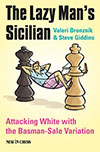 The Lazy Man’s Sicilian
The Lazy Man’s Sicilian
Attack and Surprise White with the
Basman-Sale Variation
by Valeri Bronznik & Steve Giddins
New in Chess
http://www.newinchess.com/
222 pages
Price € 19,95
ISBN 978-90-569-1605-3
The Lazy Man’s Sicilian from Bronznik & Steve Giddins is an
expanded and updated work from Valeri Bronznik 2004 book “Sizilianisch
fúr Müssiggänger Kania Verlag 2004.
In Yearbook issue 73 Srdjan Sale described Bronznik work as a
model for a good openings book so I am pleased that the fundamentals of
this masterpiece has not be changed by Steve Giddins for this
English
translation.
Giddins has updated the theory for developments over the past 11 years
where several Yearbook Surveys and other relevant printed material has
been added,
and Giddins engine of choice for this book has been Stockfish 5.64.
A great game of interest is Hage,Henk H - Van der Berkmortel,Theo JG
[B44]
NED-Cup corr Netherlands, 1995
1.e4 e6 2.d4 c5 3.Nf3 cxd4 4.Nxd4 Bc5 5.Be3 Qb6 6.c3 Nc6 7.Nd2 Nxd4
8.Nc4 Qc6 9.Bxd4 Qxe4+ 10.Be2 Be7 11.0-0 Nf6 12.Bf3 Qf4 13.Qa4 0-0
14.Be5 Qg5 15.Rfe1 Ng4 16.h4 Qxh4 17.Bg3 Qg5 18.Nb6 axb6 19.Qxa8 f5
20.Qb8 f4 21.Bxg4 Qxg4 22.Re4 g5 23.Bh2 d5 24.Ree1 h5 25.Qe5 f3 26.Qg3
Qxg3 27.Bxg3 g4 28.Rad1 b5 29.Rd4 fxg2 30.Re5 Bf6 31.Rxh5 Bxd4 32.cxd4
Bd7 33.Be5 Rc8 ½-½.
Unfortunately Henk Hage,1943 – 2001 was not aware that his game made it
in this master work.
Conclusion: This is a must have openings book!

Risk & Bluff in Chess
The Art of Taking Calculated Risks
by Vladimir Tukmakov
New in Chess
http://www.newinchess.com/
220 pages
Price € 24,95
ISBN 978-90-5691-595-7
Why are strong players often so lucky in complicated positions?
We all know the Magic from Tal with his unique attacking style.
Was it all risk and bluff? Grandmaster Vladimir Tulmakov reveals in
this book the secrets of calculated risks,all well explained at the
hand of 106 games.
All material is well packed in the following chapters: Mikhail Tal:The
start of a new era
Bluff in the opening,The madness of the brave,The logic of the
irrational,By right of strong,Masculine Desperation,In the grip of
passion,When a win
is the only acceptable result and at last The last Chance.
Very readable are the back ground stories in the book as for example as
the move 11.Kd1!?
Tal – Botvinnik Moscow Wch match 1960:1.e4 e6 2.d4 d5 3.Nc3 Bb4 4.e5 c5
5.a3 Bxc3 6.bxc3 Qc7 7.Qg4 f5 8.Qg3 Ne7 9.Qxg7 Rg8 10.Qxh7 cxd4.
The history of this far from obvious move is quite obscure.
One of the legends,propagated by Tal all his life,has it that the move
11.Kd1 was spotted by Tal’s trainer Alexander Boblents,in a chess
magazine which was lying randomly on the floor,and this happened
literally half an hour before the start of this game!And it seems the
challenger,without looking at any of the numerous tricky
variations,just said ‘Excellent,I will play it’.This is a lovely
story,fully supporting the legend
of the Riga Magician,but such stories rarely pass the test of common
sense.11.Kd1!? was introduced into practice by Gligoric,in a game
against
Petrosian.This was at the 1959Candidates tournament,the very event won
so famously by Tal!
Going throw this book I realized why he is currently the coach of the
Dutch star Anish Giri!
Conclusion: Smashing!

The English Opening Vol. 1
by Simon
Williams
2015
http://www.chessbase.com
E-Mail info@chessbase.com
Price Euro 29.90
Pentium-Processor at 300 Mhz or higher, 64 MB RAM, Windows XP, Windows
Vista, Windows 7, DVD drive, mouse, soundcard
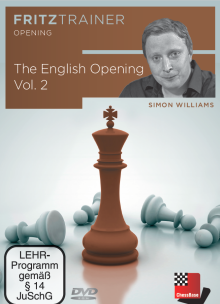
The English Opening Vol. 2
by Simon Williams
2015
http://www.chessbase.com
E-Mail info@chessbase.com
Price Euro 29.90
Pentium-Processor at 300 Mhz or higher, 64 MB RAM, Windows XP, Windows
Vista, Windows 7, DVD drive, mouse, soundcard
The chess genius GM Simon Williams provides the use of these two
DVD’s with a complete coverage of the English opening where Williams
handles in part one the following lines:
The Reversed Sicilian – 1 c4 e5 2 Nc3 Nc6 3 Nc3 Nf6 4.d4
,c4 e5 2 Nc3 Nc6 3 Nf3 f5 4 d4,1 c4 e5 2 Nc3 Nc6 3 Nf3 g6 4 d4,1 c4 e5
2 Nc3 Bb4.
The Mikenas-Carls variation – 1 c4 Nf6 2 Nc3 e6 3.e4,
1 c4 e6 2 Nc3 d5 3 e3!? And some crazy lines as we can see in the game:
Williams,Simon Kim (2513) - Rudd,Jack (2305) [A22]
London e2e4 Diamond Jubilee op London (2), 03.06.2012
1.c4 Nf6 2.Nc3 e5 3.Nf3 e4 4.Ng5 b5 5.d3 bxc4 6.Ngxe4 cxd3 7.Qxd3 Bb7
8.Bg5 Qe7 9.Bxf6 gxf6 10.0-0-0 Bg7 11.Ng3 Qe6 12.Nf5 Bf8 13.e4 Nc6
14.Qb5 0-0-0 15.Bc4 Qe5 16.Qxe5 Nxe5 17.Bd5 c6 18.Bb3 Bc5 19.f3 Rhg8
20.Na4 Bf2 21.f4 Ng6 22.Rhf1 Bb6 23.Nxb6+ axb6 24.Nd6+ Kc7 25.Nxf7 Rde8
26.Nd6 1-0.
Running time is a impressive 6 hours and 21 minutes.
All material is brought up under set-ups so there is not to much
memorizing here!
Just go for the six hours!
Part two covers The Symmetrical English 1 c4 c5 2 Nc3 Nc6 3 g3 g6 4 Bg2
Bg7 5 a3!?
2: …d5 from Black in the Symmetrical English 1 c4 c5 2 Nc3 Nf6 3 g3 d5,
The Kings Indian Defence – 1 c4 Nf6 2 Nc3 g6 3 g3 Bg7,
The Anti-Grunfeld – 1 c4 Nf6 2 Nc3 d5,
The English Defence – 1 c4 b6,
The Slav – 1 c4 c6 2 Nc3 d5 3 e3!? and at last the Dutch 1 c4 f5 where
Williams is a great expert of,so it is no suprice to see Williams here
on the black side: Snape,Ian (2258) - Williams,Simon Kim (2452) [A10]
Hastings Masters op Hastings (1), 28.12.2005
1.c4 f5 2.Nc3 Nf6 3.g3 e6 4.Bg2 Be7 5.d3 0-0 6.e4 fxe4 7.dxe4 Nc6 8.f4
e5 9.Nf3 exf4 10.gxf4 Ng4 11.h3 Bh4+ 12.Ke2 Nh6 13.Be3 d6 14.Qd2 Kh8
15.Nd5 Bf6 16.Raf1 Re8 17.Ng5 Bxg5 18.fxg5 Ng8 19.g6 Ne5 20.Bg5 Qd7
21.gxh7 Kxh7 22.Qf4 Re6 23.Qh4+ Nh6 24.Nf6+ Rxf6 25.Rxf6 Nef7 26.Bxh6
Nxh6 27.Rf8 Qa4 28.Rhf1 Qc2+ 29.Ke3 Qxg2 30.R1f2 Qg1 31.Qd8 Qg3+ 32.Kd2
Ng8 33.R2f3 Qg2+ 34.Ke3 Qg1+ 35.Kd3 Qd1+ 36.Ke3 Qc1+ 37.Kf2 Qxb2+
38.Kg1 Qd4+ 39.Rf2 Qxe4 40.R2f4 Qe3+ 41.Rf2 Qe1+ 42.Kh2 Qe5+ 43.Kg1 b5
44.Qxc7 Bxh3 45.R8f4 Nh6 46.R2f3 Qg5+ 47.Kf2 Qg2+ 48.Ke3 Re8+ 49.Kd3
Qe2+ 0-1.
Video running time is 5 hours and 50 minutes.
Included are extra databases and testing positions to see if you have
understood the lessons from Williams.
Conclusion: These two DVD’s off you an killing coverage of the move
1.c4!
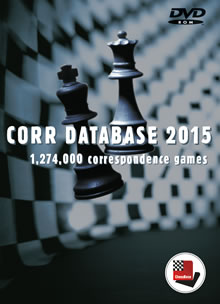
ChessBaseDatabase
Corr Database 2015
2015
http://www.chessbase.com
E-Mail info@chessbase.com
€99.90
€83.95 without VAT (for Customers
outside the EU)
$93.45 (without VAT)
Pentium-Processor
at 300 Mhz or higher, 64 MB RAM, Windows XP, Windows
Vista, Windows 7, DVD drive, mouse, soundcard
1 GHz Pentium PC, Windows 10, 8.1, 8
oder Windows 7/Vista/XP, 512 MB RAM, DVD-ROM drive, ChessBase 11, 12 or
13.
Correspondence Database 2015 is a heavy loaded
collection of correspondence games, the American economic basis
for correspondence chess can be credited to the New Jersey banker
John Lee,who served in Congress from 1867 to 1873 and in 1881-1882.
In a later interview with a local newspaper,Lee took well deserved
credit for inventing America’s “penny postcard,” some thirty years
after Gossip claims its origin in Europe.
Correspondence Chess in America by B.Avery McFarland 2000.
Nowadays correspondence games are played by mail and by
webserver. This CD contains 1 274 459 games,all played from 1804 until
2015.
So you will find all games from the World championships correspondence
chess, but also European chess championships plus various National
championships.
Compared with Correspondence Database 2013 we have here over 232316
more correspondence games!
The nowadays correspondence player or may I say computer chess player
is well prepared with fast computers and multi core processors.
And that makes these correspondence game interesting for latest chess
developments because correspondence chess players enjoy the latest
lines of chess theory.
One of the greatest correspondence players is certainly CJS Purdy,the
first world champion is correspondence chess,the story is that Purdy
did not loose a game of correspondence chess between 1937 and 1952!
Not many are aware of it but when Purdy was educated at the Cranbook
School in Tasmania one of his classmates was future film star Errol
Flynn.
Purdy decided at the age of 16 to become a full time chess writer and
player.
Included on this DVD is a correspondence chess players base from around
80.000 entries.
Conclusion: Impressive made!
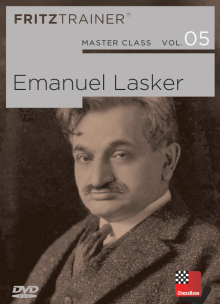
Master Class Vol. 5: Emanuel Lasker
by Dr. Karsten Müller, Mihail Marin, Oliver Reeh, Niclas
Huschenbeth
http://www.chessbase.com
E-Mail info@chessbase.com
Price Euro 29.90
Pentium-Processor at 300 Mhz or higher, 64
MB RAM, Windows XP, Windows
Vista, Windows 7, DVD drive, mouse, soundcard
Emanuel Lasker born, December 24, 1868 – died January 11, 1941)
was a German chess player, mathematician, and philosopher who was World
Chess Champion for 27 years and well from 1894 till 1921.
John Nunn wrote in his book: John Nunn’s Chess Course Gambit 2014; I
decded on Lasker for variety of reasons. His chess credentials are
impeccable. as he was World champion for 27 years, longer than any
other person. Moreover he had what is often termed a universal style,
in that he could handle all types of position well, and there fore a
study of his games would
Benefitts all aspects of the reader’s play.
On this DVD you shall find all Lasker games 1224,Lasker trainings
questions 106 games, tables, background knowledge, and even a
short biography.
Interesting to mention is that there are detailed investigations of
Lasker’s playing style (by Knaak, Rogozenco, Stohl, etc.
Plus a Lasker powerbook with the world champion’s opening repertoire as
a variation tree.
Lasker’s most famous game is probably Lasker,Emanuel - Bauer,Johann
Hermann [A03]
Amsterdam Amsterdam (1), 26.08.1889
[Kasparov]
This game contains one of the beautiful combinations of the young
Lasker which created a blueprint for future similar double bishop
sacrifices that destroyed the lives of dozens of his opponents' kings.
Diese Partie beinhaltet eine der schönsten Kombinationen des
jungen Lasker, die späteren Läuferpaaropfern als Vorbild
diente und zahlreiche gegnerische Könige das Leben kostete. 1.f4
d5 2.e3 Nf6 3.b3 e6 4.Bb2 Be7 5.Bd3 b6 6.Nf3 Bb7 7.Nc3 Nbd7 8.0-0 0-0
9.Ne2 c5 10.Ng3 Qc7 11.Ne5 Nxe5 12.Bxe5 Qc6 13.Qe2 a6
r4rk1/1b2bppp/ppq1pn2/2ppB3/5P2/1P1BP1N1/P1PPQ1PP/R4RK1 w - - 0 0
After very passive Black play in the opening White's army is ready for
action, and Lasker begins the final storm Nach sehr passivem schwarzen
Spiel in der Eröffnung stehen die weißen Figuren zum Angriff
bereit. Lasker beginnt nun die entscheidende Attacke. 14.Nh5 Nxh5
[14...d4 15.Bxf6 Bxf6 16.Qg4 Kh8 (16...e5 17.Be4!) 17.Rf3 Rg8 18.Bxh7!]
15.Bxh7+! [15.Qxh5 f5 achieves nothing. führt zu nichts.]
15...Kxh7 16.Qxh5+ Kg8 17.Bxg7!! Today Lasker might have tried to
copyright this idea. Heutzutage würde Lasker vielleicht versuchen,
diese Idee urheberrechtlich für sich in Anspruch zu nehmen.
17...Kxg7 18.Qg4+ Kh7 19.Rf3 e5 20.Rh3+ Qh6 21.Rxh6+ Kxh6 Black has
narrowly escaped mate, but Schwarz ist knapp dem Matt entronnen, aber
22.Qd7! wins a piece and the game. gewinnt eine Figur und die Partie.
22...Bf6 23.Qxb7 Kg7 24.Rf1 Rab8 25.Qd7 Rfd8 26.Qg4+ Kf8 27.fxe5 Bg7
28.e6 Rb7 29.Qg6 f6 30.Rxf6+ Bxf6 31.Qxf6+ Ke8 32.Qh8+ Ke7 33.Qg7+ Kxe6
34.Qxb7 Rd6 35.Qxa6 d4 36.exd4 cxd4 37.h4 d3 38.Qxd3 1-0.
17.Bxg7 and 15.Bxh7+!! established Lasker’s reputation,as Carlos Torre
did with 25.Bf6!! against lasker at Moscow 1925 and Fischers 17….Be6!!
against Donald Byrne.
There are not many Lasker games between 1927 and Zurich 1934 but I did
like the following one: Lasker,Emanuel - Bernstein,Sidney Norman [B03]
New York clock sim (1:10) New York, 08.11.1928
1.e4 Nf6 2.e5 Nd5 3.c4 Nb6 4.d4 d6 5.f4 dxe5 6.fxe5 g6 7.Nc3 Bg7 8.Be3
c5 9.dxc5 N6d7 10.e6 fxe6 11.Nf3 Qa5 12.Rc1 Nxc5 13.Bd4 e5 14.Nxe5 Bxe5
15.Bxe5 Nd3+ 16.Bxd3 Qxe5+ 17.Qe2 Nc6 18.0-0 Qxe2 19.Bxe2 Be6 20.Rfe1
0-0-0 21.Bf3 Bxc4 22.Bxc6 bxc6 23.Rxe7 Rd7 24.Rxd7 Kxd7 25.Kf2 Re8
26.b3 Bf7 27.Na4 Re5 28.Rc5 Kd6 29.Rxe5 Kxe5 30.Ke3 Bd5 31.g3 Be4
32.Nc5 Bb1 33.a3 Ba2 34.Kd3 Kd5 35.b4 a5 36.Kc3 axb4+ 37.Kxb4 Bc4
38.Nd7 Bd3 39.a4 Kd4 40.a5 Ke3 41.Kc5 Kf2 42.Nf8 Kg2 43.Nxh7 Kxh2 44.g4
Kg3 45.g5 Bb5 46.Kb6 1-0.
Conclusion: This is a must buy for all
lovers of the great Lasker!
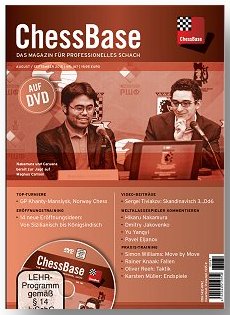 ChessBase Magazine issue 167
ChessBase Magazine issue 167
2015
August /September
http://www.chessbase.com
E-Mail
info@chessbase.com
ISSN 1432-8992
Price Euro 19.95
First of all I would like to start with the Tournaments
file,good for 1772 entries where a small 32 of them cover excellent
annotations as the following one from Vladimir Kramnik,(2783) -
Caruana,Fabiano (2805) [D78]
Dortmund SuperGM 43rd Dortmund (5), 03.07.2015
[Sagar Shah]
After four rounds Kramnik was jointly leading the tournament with Liviu
Dieter Nisipeanu with 3.0/4. Caruana was half a point behind with
2.5/4. 1.Nf3 d5 2.g3 g6 3.Bg2 Bg7 4.d4 Nf6 5.0-0 0-0 6.c4 c6 The solid
setup against the Fianchetto Grunfeld is one of the toughest systems
for white to crack. But who better than the big Vlad to give it a try!
7.Nbd2 [7.Qb3 has become quite popular recently.;
7.cxd5 cxd5 Even though White has an extra tempo I don't believe he has
serious chances of obtaining an advantage.;
7.b3 dxc4 8.bxc4 c5 is quite a heavily analyzed line.] 7...a5 [7...Bf5
is much more common. A typical line of play would go something like
this: 8.b3 Ne4 9.Bb2 Nd7 10.Nh4 Nxd2 11.Qxd2 Be6 12.e4 dxe4 13.Bxe4 Bh3
14.Rfe1² with a slight edge for White. This had been played
between Nakamura and Leko in 2012 London GP.] 8.b3 a4 9.Ba3!? [9.Bb2 is
the more common move but î?§a3 is the latest innovation and
has been scoring quite decently for White. 9...Bf5 with an interesting
position.] 9...axb3 10.axb3 Bf5 11.Nh4 Be6 12.Re1 White prepares the
move e4. [12.e4? dxe4 13.Nxe4 Nxe4 14.Bxe4 Qxd4µ;
12.Qc2!? has a nice trap of î?§xe7 unleashing a discovered
attack on the rook on a8. 12...dxc4? (12...Nbd7 13.e3²
(13.e4?! dxe4 14.Nxe4 Nxe4 15.Qxe4 Qb6³) ) 13.Bxe7!±]
12...Ne4 13.Bxe4!? A very unorthodox exchange by Kramnik. He is trying
to spice up the position. [13.e3 was a safer choice with a slightly
preferable position for White.;
13.Nxe4 dxe4 14.Bxe4 Qxd4 15.Qxd4 Bxd4 16.Bb2! Rxa1 17.Bxa1 Bg7= would
have lead to a handshake pretty soon.] 13...dxe4 14.Nxe4 [14.e3= was
necessary as the move chosen by Kramnik in the game leads to a clearly
inferior position.] 14...Qxd4 [14...Bxd4? 15.Bxe7!± just drops a
pawn.] 15.Qc2!? This is objectively a bad move. However, it takes many
precise moves from Caruana to prove that. If Black were to play
anything apart from î?§f5 on the next move then White has a
fine position. [15.Qxd4 Bxd4 16.Bb2 Rxa1 17.Bxa1 Bb6³ Keeping the
double bishops. Of course, this was not the reason why Kramnik had
given up his light squared bishop on e4.] 15...Bf5! An excellent
tactical resource that might have been missed or underestimated by
Kramnik. [15...Qxa1?! 16.Rxa1 Bxa1 17.Bxe7± The queen will prove
to be much stronger in such a position, with the knights on the board,
than the two rooks.;
15...Nd7 16.Rad1 Qb6 17.Bxe7 Rfe8 18.Bd6÷ Black has compensation
but White is not worse.;
15...Re8 16.Bb2 Rxa1 17.Bxa1 Qb6 18.Bxg7 Kxg7 19.Rd1=] 16.Nxf5 gxf5
17.Ng5 [17.Nd2 Qc3! is the neat little point. 18.Qa2 Qa5µ The
exchange is lost.;
17.Nc5 Rxa3 18.Rxa3 Qxc5µ] 17...Qg4 The queen attacks the knight
and the bishop on g7 uncovers an attack on the a1-rook. 18.f4 Bxa1
19.Rxa1 h6?! [19...c5! would have given Caruana a nearly decisive
advantage. The idea is to develop the knight on c6 where it will be
much more active than on d7 as in the game. 20.Bb2 (20.Qc3 Nc6 21.Bxc5
Rxa1+ 22.Qxa1 Qxe2-+ The is the difference of not playing h6 and
pushing the knight back to f3.) 20...Rxa1+ 21.Bxa1 Nc6µ] 20.Nf3
Nd7 [20...c5 would no longer be strong because 21.Qc3 Nc6 22.Bxc5³
when Black's advantage is reduced to a minimum.] 21.Rd1! Kramnik takes
his best practical chance to keep the rooks on board. 21...Rxa3 22.Rxd7
Qh3! Keeping an eye on the white king. 23.Qc3 e6?! This terribly
weakens the f6 square and gives White enough counterplay against the
f7-point. [23...Rfa8 would have been much stronger as after 24.Rxe7?!
(24.Rxb7? Ra1+ 25.Kf2 Rf1+ 26.Ke3 Qg2-+) 24...Ra1+ 25.Kf2 (25.Ne1 Rb1
(25...Rd1 26.b4 b6 27.c5 bxc5 28.bxc5 h5-+) 26.b4 b6 The rook on e7
cannot give up the e-file is the main reason for the zugzwang. 27.c5 b5
28.Rd7 Re8-+) 25...Rf1+ 26.Ke3 Qg2-+ The attack against the white king
breaks through. The most critical move î?¥f6 is refuted in
the following manner: 27.Qf6 Rxf3+! (27...Qf2+?! 28.Kd3 Rd1+ (28...Rd8+
29.Kc2±) 29.Kc3 Rc1+ 30.Kd2 (30.Kd3? Rd8+-+) 30...Ra2+ 31.Kd3
(31.Kxc1 Qf1++-) 31...Rd1+ 32.Kc3 Rc1+ 33.Kd3=) 28.exf3 Qg1+ 29.Kd3
Qd1+ 30.Ke3 (30.Kc3? Qa1+-+) 30...Qe1+ 31.Kd3 Rd8+! 32.Kc2 Rd2+ 33.Kc3
Re2+-+] 24.Rxb7 Rfa8 25.Kf2 Ra1 26.Ke3! The king is safe on the
e3-square. 26...Rf1 27.Qf6 Rf8 Once the rook has to passively defend
the f7-point, it is clear that White cannot be worse. 28.Rd7 [28.Kd4!?
In this age where we are seeing king walks in almost every other
tournament this move would have been really loved by the spectators. It
doesn't really change the assessment of the position but Black has to
quickly find a way to get his queen into the game. Most probably the
game would end something like this 28...Qg2 29.Qxh6 Qxe2 30.Qg5+ Kh7
31.Qh4+ Kg8 32.Qg5+=] 28...Rb1 29.Rb7 c5 30.Rb5 Rf1 31.Nd2? It is quite
possible that Kramnik was under time pressure as this gives Black the
golden opportunity to get a winning position. [31.Rxc5 Rxf3+ 32.exf3
Qxh2= would have ended in a draw.] 31...Rc1 32.Qb2 [32.Nf3 Qf1! 33.Qxh6
Rc3+ 34.Kd2 Qc1#] 32...Rd1 33.Qc2 Rh1 White has lost all his
co-ordination and now the Black pieces weave a deadly attack. 34.Nf3
Qg2 35.Qc3 Rf1 36.Qf6 Rf2 37.Kd3 [37.Qb2 Rxf3+-+] 37...Rxe2 38.Ng5 Rd2+
What an exciting game. First Kramnik plays the opening in dubious
fashion and gets a minus position. Caruana makes one inaccurate move
and just when we felt that the game was heading towards a draw, Kramnik
makes a very huge mistake by playing î?¨d2. After that
Caruana finished off the game to perfection.[38...Rd2+ 39.Kc3 Rc2+
40.Kd3 Qd2#] 0-Others are: 1. Nakamura analyses his swift black
win against Aronian (English with 1.c4 e5 and 3...Bc5)
2. Yu,Y - Dominguez Perez,L: The shooting-star from China shows his
attacking game full of Najdorf patterns
3. Tiviakov: The Scandinavian expert reveals in a video why his system
with 3...Qd6 no longer works!
4. A comfortable Anti-Sicilian: 1.e4 c5 2.b3 - Opening article by IM
Illingworth
5. Taktics! Solve Oliver Reeh's favorite combination. With
videofeedback.
6. Norway Chess 2015: Enjoy the best games of "Norway Chess 2015" with
video analyses by Daniel King!
7. Opening trap: 1.Nf3 f5 2.d3! After 2...Nf6 Black already fell for
it! Rainer Knaak shows how White gets an advantage.
8. How good is your endgame technique? Find the win in
Tomashevsky-Grischuk (video)
9. The brilliancy Wei Yi - Bruzon Batista: rook sacrifice, king hunt,
and a lot of quiet moves!
10. "Move by Move": Play like Anish Giri! Join GM Williams to find the
masterful moves of the Dutch GM.
Included are the following openings surveys: Opening Surveys
Stohl: English Mikenas A18
1.c4 Nf6 2.Nc3 e6 3.e4 d5 4.cxd5 exd5 5.e5 Ne4,Ris: English A22
1.c4 e5 2.Nc3 Nf6 3.g3 Bb4 4.Bg2 0-0 5.e4 Bxc3 6.bxc3,Marin: Kangaroo
Defence A40
1.d4 e6 2.c4 Bb4+ 3.Nd2 b6,Schipkov: Wade Defence A41
1.d4 d6 2.Nf3 Bg4 3.c4 Bxf3 4.exf3,Illingworth: Sicilian Defence B20
1.e4 c5 2.b3,Berg: Sicilian Defence B22
1.e4 c5 2.c3 d5 3.exd5 Nf6,Krasenkow: Sicilian Defence B30
1.e4 c5 2.Nf3 Nc6 3.Bb5 e6,Gormally: Sicilian Defence B47
1.e4 c5 2.Nf3 e6 3.d4 cxd4 4.Nxd4 Nc6 5.Nc3 Qc7 6.f4,Postny: Sicilian
Defence B90
1.e4 c5 2.Nf3 d6 3.d4 cxd4 4.Nxd4 Nf6 5.Nc3 a6 6.h3 e5 7.Nde2
h5,Havasi: French Defence C03
1.e4 e6 2.d4 d5 3.Nd2 h6,Souleidis: Philidor Defence C41
1.e4 d6 2.d4 Nf6 3.Nc3 e5 4.Nf3 Nbd7 5.Bc4 exd4,Kuzmin: Queen's Gambit
D38
1.d4 d5 2.c4 e6 3.Nf3 Nf6 4.Nf3 Bb4 5.Qb3,Schandorff: Semi-Slav D48
1.d4 d5 2.c4 c6 3.Nf3 Nf6 4.Nc3 e6 5.e3 Nbd7 6.Bd3 dxc4 7.Bxc4 b5 8.Bd3
Bb7 and at last Szabo: King's Indian E90
1.d4 Nf6 2.c4 g6 3.g3 Bg7 4.Bg2 0-0 5.Nc3 d6 6.Nf3 Nbd7 7.0-0 e5 8.e4
exd4 9.Nxd4 Re8 10.h3 a6 11.Re1.
Included are the following colums:Williams Move by Move,Rogozenco: The
classic,Reeh Tactics,Müller endgames,Knaak The Opening Trap,and a
Super Telechess file from over 12000 entries!
Conclusion: Super material!
This all come with a eye catching booklet in two
languages!







